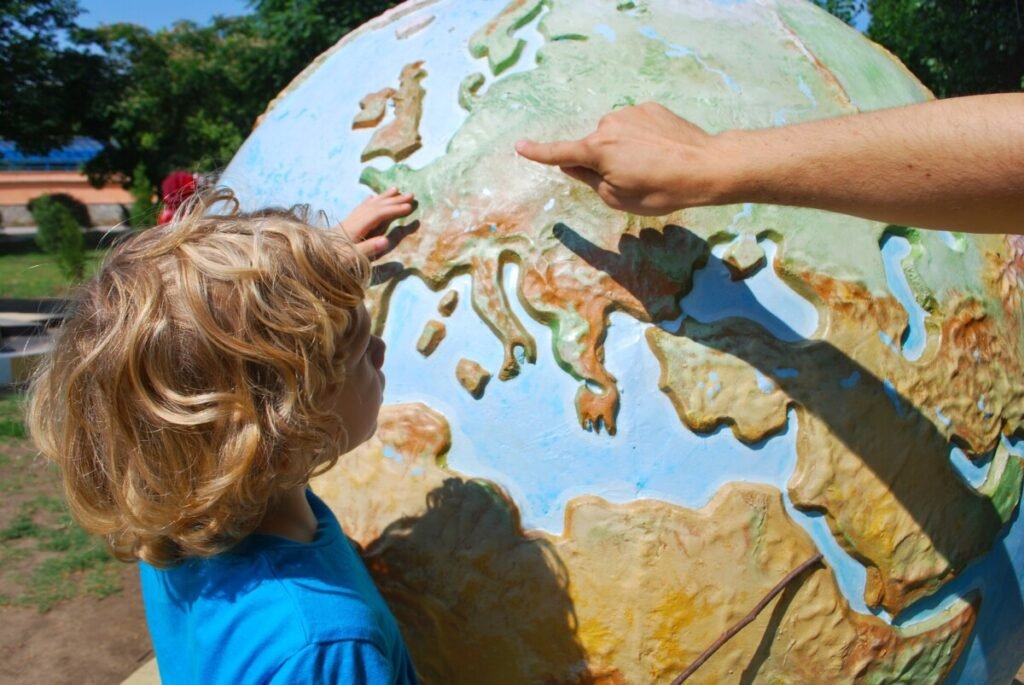
Traveling with family – Collab Tips
These Families Offer Their Tips on How to Make Traveling With Family Work in 2025
Traveling with your family can be one of life’s greatest adventures or its most challenging tests. As parents who’ve figured out airports with screaming toddlers or road trips with teenagers glued to their phones, Our experts have learned that family travel success comes from experience – both your own and others.
Here we’ve gathered all the insights you need from families who’ve turned travel challenges into treasured memories, and they’re eager to share their hard-won wisdom with you.

Hi there! I’m Emily, a travel writer with a passion for exploring the great world we live in. I love to share my travel wisdom where possible to ensure people can truly make the most of the time when they visit places. One of my most memorable trips was Rio De Janeiro in Brazil, that city has some of the most wonderful, crazy energy!
Affiliate Disclosure: Some of the links on our site are affiliate links, meaning, at no additional cost to you, we may earn a commission if you click through and make a purchase. This helps us to continue providing valuable content and supports our efforts in bringing the travel community together. We only recommend products and services we believe in and think you’ll find useful. Complete details are included in our affiliate disclaimer. Thank you for your support!
In a Hurry? Here's our Key Info for This Article
- Involve children in trip planning by giving them age-appropriate research tasks and decision-making roles to create excitement and investment in the journey.
- CPack strategically by focusing on essential versatile items and buying bulky necessities like diapers and sunscreen at your destination to save luggage space.
- Balance screen time with real-world engagement by using devices strategically for transitions while encouraging children to connect with locals and explore their surroundings.
- Build flexibility into every itinerary because rigid schedules rarely survive contact with children's unpredictable needs and energy levels.
- Prioritize parental well-being through separate bedrooms and kid-free time, as happy parents create the positive energy that makes family travel successful.
Essential Apps
Surfshark VPN
Stay safe online and continue accessing all your services just like back home.
Real Families, Real Adventures
Traveling with family is all about discovering what your family is capable of together. That might be general travel or being a successful digital nomad family. Some people consider their traveling days over after having kids but there are families who’ve turned travel challenges into their greatest strengths.
These real families across the globe are proving that exploring the world with children isn’t just possible – it’s a way to introduce a passion with the ones closest to them. These families have learned that the key isn’t avoiding difficulties, but embracing them as part of the journey.
Tips from Family Travelling Experts
We spoke with three families who gave us their quotes and insights into how different families travel. Solo traveling parents can have a different experience to those with large families and three collaborators know it best, sharing their tips from real-life travel.
Lulu @nomadmumblog

"Happy parents, happy kids - that's our golden rule. We put us first. We prioritize separate bedrooms, regular date nights, and kid-free time. It keeps our relationship healthy, helps us parent with more patience, and stay (mostly) sane while traveling full-time."
This approach of prioritizing parental well-being is strategic. When parents maintain their relationship and mental health during travel, children feel more secure and adaptable. The ripple effect of happy, centered parents creates a positive travel atmosphere where unexpected challenges become adventures rather than disasters. Many families find that booking connecting rooms or family suites, even when it costs more, pays dividends in everyone’s mood and energy throughout the trip.
Roxy June @roxyjuneofficial
"As a solo mama I've chosen to create memories for my kid, along side her. Traveling has allowed us to experience the world and cultures with all of our senses. It's given us commonality, conversation and community. I do my best to balance intentional strategy with knowing that plans often times need to be revisited and pivot."
Roxy June shows that Solo parent travel presents distinct challenges, but also unique opportunities for deep bonding. Without the ability to tag-team parenting duties, solo parents often develop more intentional travel strategies and stronger communication with their children. The key is building flexibility into every plan while maintaining just enough structure to help children feel secure. Many solo parent travelers find that involving their children as “co-pilots” in choosing what to do and where to go creates a sense of teamwork that strengthens their relationship both on the road and at home.
Traveling With Five @travelling_with_five
"Travel changes you as a family, you learn and grow together while experiencing the wonder of the world. We stay balanced by including learning into our travel experiences, ensuring that we take something away from each cutural experience."
Large families face logistics that can seem overwhelming, but they also enjoy advantages that smaller families miss. Children in larger traveling families often develop strong problem-solving skills and learn to be more independent and helpful. The secret is treating the family as a team where everyone has age-appropriate responsibilities. From the 6-year-old who’s in charge of counting heads during group movements to the teenager who researches local customs, each family member becomes invested in the success of the journey when they have a meaningful role to play.
Planning Together Makes Everyone Feel Invested
Successful family trips begin long before you pack your bags. Involving children in the planning process creates excitement and gives them a sense of ownership in the adventure.
How can I involve young children in travel planning?
Involving your children in planning process, by looking at maps together and creating lists of activities will leave them always asking themselves, “What can we do, see, eat, and experience here that we can’t do at home or anywhere else?”
For younger children, try showing picture books about your destination, watching age-appropriate videos together, or letting them choose between two pre-selected activities for each day.
What about teenagers? How do I keep them engaged?
Give teens specific research assignments based on their interests. If your teen loves food, have them research local specialties and pick one restaurant for the family to try. If they’re into history, let them plan a museum visit or historical site tour.
Building in one-on-one time with each child works a treat. If the teens want to stay in the hotel and watch TV, take the others to the pool. Group dynamics are a lot, so yu should be okay with breaking off to make one kid the focus of your attention.
The Three Stages of Planning
Traveling with family planning can be broken down into three manageable stages:
- Early Stage (6 months out): Answer big questions like budget, destinations, and trip length. Focus on what you want your family to experience and learn.
- Mid Stage (1 month out): Refine plans with specific flights, accommodations, and seasonal considerations. Consider consulting a travel agent for complex itineraries.
- End Stage (ongoing): Plan day-to-day activities, meals, and local transportation. Leave room for spontaneity and unexpected discoveries.
“The most successful family trips have structure but aren’t overscheduled. Children need downtime to process new experiences, and parents need flexibility to adapt when things don’t go as planned.”
— Dr. Emily Carter, Child Psychologist and Family Travel Expert
Packing Hacks When Traveling With Family


Overpacking is the nemesis of family travel. Experienced parents have learned to streamline their approach, focusing on versatility and buying essentials at their destination.
Essential Gear That’s Worth the Space
For Babies & Toddlers
- Pockit Air Micro Stroller: “It pops open in two seconds and fits kids from 6 months to 5 years,” says David DiGregorio.
- Inflatable Bed Bumpers: Compact solution for preventing falls from hotel beds.
- Backup Comfort Item: “Hide a ‘dupe stuffie’ in your bag in case your kiddo loses their most treasured friend,” advises Cinzia Reale-Castello.
- Snack Supply: “Kids wake up and expect breakfast, so be prepared,” says Campbell Levy, father of three boys under six.
For School-Age & Teens
- Toddler-sized Hiking Packs: Let kids carry their own small essentials and snacks.
- Tablet with Downloaded Content: “Be sure to download videos for offline viewing in advance,” advises Chris Bergaust.
- Travel Journal: Encourages kids to document their experiences and stay engaged.
- Power Bank: Essential for keeping devices charged during long travel days with teens
What to Buy at Your Destination
Kathryn Romeyn suggests buying these items after arrival to save luggage space:
- Diapers (bring just enough for the first day)
- Sunscreen and bug spray
- Snacks and basic food items
- Bulky items like beach toys
| Travel Type | Packing Strategy | Key Items |
| Beach | Minimalist with local purchases | UPF clothing, one small sand toy, swim diapers |
| City | Comfort and mobility focus | Compact stroller, carrier, comfortable shoes |
| Outdoor | Layered essentials | Child carrier backpack, weather protection, first aid |
| Long-haul Flights | Entertainment and comfort | Surprise toys, comfort items, change of clothes |
How to Keep the Kids Engaged
While some parents can rely on screens to keep peace during travel, the most memorable family trips incorporate activities that engage children with their surroundings and create meaningful connections.
Balance Screen Time with Real Experiences
Many traveling parents told us they relax screen time rules while traveling but use them strategically. “Peppa Pig was our secret weapon,” says Chris Schalkx, whose son Ollie is now 6, “when we needed to keep him quiet on public transport or in a fancy restaurant.”
It is recommended to switch off electronics 10 minutes before arriving at destinations – It gives kids a chance to reset and be less grumpy.
Quick Tip: Create a digital scavenger hunt for older kids. Give them a list of things to photograph at your destination – local food, interesting signs, unique architecture—to keep them engaged with their surroundings while still using technology.
Connect with Locals and Other Children
It is important to emphasize the importance of human connections. Make time and space for your children to meet the locals, talk to your drivers and encourage your children to do the same. That’s what they’ll remember.
Parents should seek out playgrounds and other places where children naturally gather. You might find yourself trying to make sure the kids don’t catch a glimpse of a playground as you pass by, but kids need the familiarity of places like that on the road as much as at home.
Educational Opportunities That Don’t Feel Like School
Language Learning
Some parents suggest teaching kids a few phrases in the native language of your destination. A little kid speaking – or attempting to speak the language will absolutely surprises people everywhere you go.
Science Museums
Science museums are interactive, good for a wide range of ages, and have the added bonus of teaching things. The California Science Center in Los Angeles and the Franklin Institute in Philadelphia are great one if you are in the United States.
| Road Trips | Flights |
| Pros: Flexible schedule, can pack more gear, stop whenever needed Cons: Limited range, potential for car sickness, longer travel time | Pros: Reach distant destinations quickly, built-in entertainment on many flights Cons: Less flexibility, baggage limitations, potential for delays |
| Best Engagement Tactics: Audio books, travel games, scenic stops, picnic lunches | Best Engagement Tactics: New small toys, activity books, snack variety, walking breaks |
Managing Meltdowns and Staying Calm When Things Go Awry
Even the most meticulously planned family trips encounter unexpected challenges. How parents respond to these moments often determines whether they become amusing family stories or vacation-ruining disasters.
The Art of Flexible Planning
Rigid itineraries rarely survive contact with young children. Planning point-to-point or A, B, C, works great when it works. but with kids, you have to be willing to abandon ship and “embrace serendipity.”
Wwhile some children crave structure and routine, they’re often more adaptable than parents realize. If you can learn to ride that edge (Sometimes it may backfire) but more often than not it will feel like you’re cultivating a healthy sense of adaptability – for parents and child alike.
“On vacation, things go wrong, new places feel scary—it happens. So, calm down because your young child will mirror your bad energy. If you can’t stay calm, at least act calm.”
— Lisa Alam Shah, Executive Director of Micato India
Practical Strategies for Difficult Moments
- Build in buffer days: Adding an extra day or two when changing time zones is great to help children acclimate.
- Schedule driving for mornings: Plan long car rides when everyone is fresh, not at the end of a busy day.
- Have a meditation app ready: Try using 3-minute “emergency calm” meditations when feeling overwhelmed by toddler behavior.
- Create a compromise system: Uses the “let’s make a deal” approach. “If you take this tour, you can spend the afternoon at the pool and on WiFi.”
- Know when to split up: Aim to accommodate different interests and energy levels.
Expert Insight – The Psychology of Family Travel


Dr. Emily Carter, child psychologist and family travel expert, explains that travel stress affects children differently depending on their age and temperament.
“Young children may become overwhelmed by sensory input in new environments, while teenagers might withdraw when feeling out of their comfort zone,” she explains. “Parents can help by maintaining some familiar routines, acknowledging feelings without judgment, and modeling positive responses to challenges.”
Dr. Carter recommends creating a simple visual schedule for each day so children know what to expect, and designating a parent to be the “emotional first responder” when signs of distress appear.
Quick Survival Kit for Meltdown Moments:
- Favorite snack (hunger often triggers meltdowns)
- Comfort item from home
- Noise-canceling headphones for sensory overload
- Small new toy for distraction
- Water bottle (dehydration affects mood)
Every family’s travel experience is unique, and your insights could help another parent make their next trip more enjoyable. What family travel tips have worked for you? What challenges have you overcome? Share your story by clicking below!
Traveling With Family Concluding Thoughts
Despite the challenges, traveling with children is worth every difficult moment. The shared experiences create bonds and memories that last a lifetime. As Campbell Levy puts it: “Kids can be jerks. I know some parents that choose to not travel with their young kids because it’s hard. But honestly, kids are going to be jerks at home, just like they’re going to be jerks while you’re traveling. Might as well be traveling.”
These families have shown that with thoughtful planning, flexible expectations, and a sense of humor, family travel can be transformative. Children develop resilience, curiosity, and global awareness. Parents gain new perspectives on their children’s capabilities and interests. And together, families create stories they’ll tell for generations.

Traveling With Family FAQ
The biggest mistake is over-planning rigid itineraries that don’t account for children’s needs and energy levels. Successful family travel requires building in buffer time, allowing for spontaneous discoveries, and being prepared to abandon plans when kids need rest or are having meltdowns.
Focus on buying bulky items like diapers, sunscreen, and snacks at your destination rather than packing them, book accommodations with kitchenettes to prepare some meals, and involve older children in finding free local activities like playgrounds, beaches, or hiking trails that provide entertainment without breaking the budget.
There’s no perfect age to start traveling with family. Babies can be surprisingly portable, while older children bring more awareness and memory formation to the experience. The key is adjusting your expectations and travel style to match your children’s developmental stage, whether that’s shorter trips for toddlers or more adventurous destinations for teenagers.
Stay calm yourself since children mirror parental energy, pack a “survival kit” with favorite snacks, comfort items, and distractions, and remember that tired, hungry, or overstimulated children will have harder times regardless of location—it’s not about the destination, it’s about managing basic needs.
Not necessarily – many families successfully visit non-traditional destinations by doing extra research on local customs, child-friendly accommodations, and cultural expectations. The key is matching your destination choice to your family’s comfort level, travel experience, and children’s ages rather than limiting yourself to obvious “family” spots.









